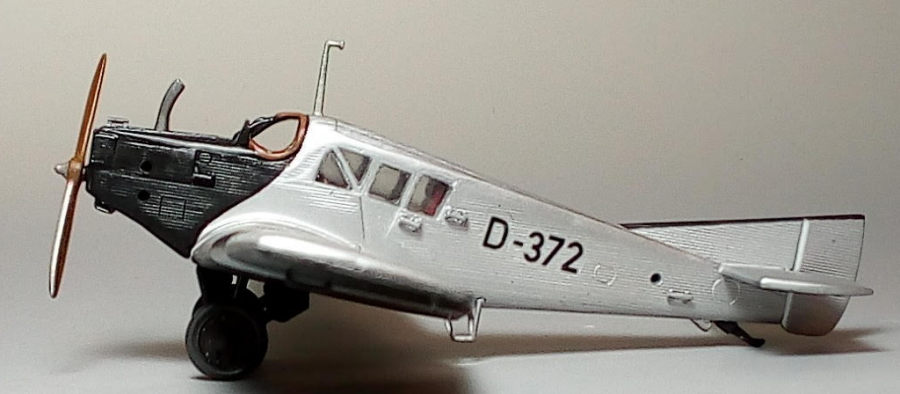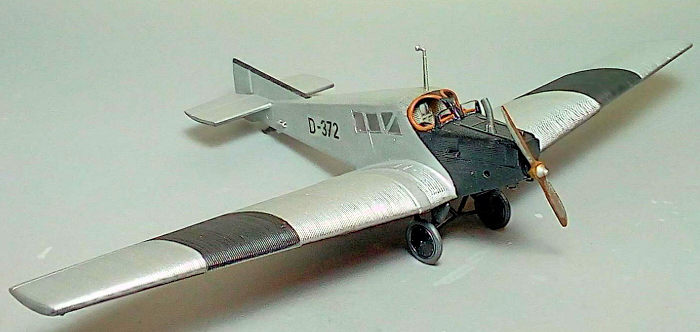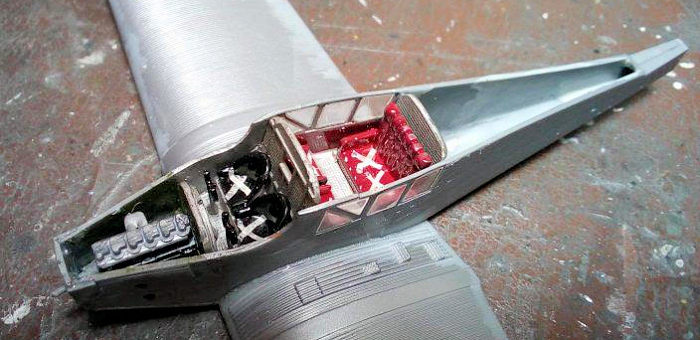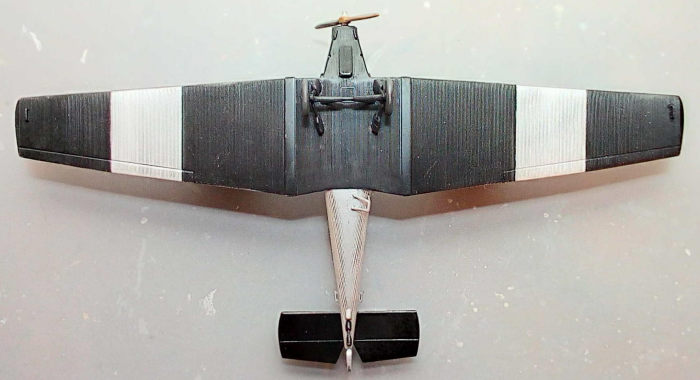
| KIT #: | 4215 |
| PRICE: | €5 on offer |
| DECALS: | Two options |
| REVIEWER: | Spiros Pendedekas |
| NOTES: |

| HISTORY |
First flown on 25 June
1919, the F.13 was Junkers' first commercial aircraft and the world's first
all-metal transport plane. Aerodynamically clean and without external bracing,
it surely stood out in an essentially biplane era, with only Fokker designs
being of comparable modernity.
Typically for Junkers,
it used a duralumin structure entirely covered with corrugated and stressed
duralumin skin. The wing structure featured nine circular cross-section
duralumin spars with transverse bracing. All control surfaces were horn
balanced.
Behind the single
engine was a semi-enclosed cockpit for the crew, roofed but without side
glazing, whereas the passenger cabin was fully enclosed and heated, with windows
and doors in the fuselage sides. Passenger seats were fitted with seat belts, an
unusual feature for the time. The plane used a fixed conventional split landing
gear with a rear skid, though some variants used floats or skis.
 The type
could be fitted with a variety of power plants, including Mercedes, BMW, Junkers
and Armstrong Siddeley Puma liquid-cooled inline, but also Gnome-Rhône Jupiter
and Pratt & Whitney Hornet air-cooled radials.
The type
could be fitted with a variety of power plants, including Mercedes, BMW, Junkers
and Armstrong Siddeley Puma liquid-cooled inline, but also Gnome-Rhône Jupiter
and Pratt & Whitney Hornet air-cooled radials.
To overcome the
restrictions imposed by the Inter-Allied Aeronautical Commission of Control,
which banned the production of warplanes and of any aircraft in the period of
1921–2, Junkers picked up orders abroad from 1919 onward in Austria, Bolivia,
Colombia, England, France, Italy, Japan, Poland, Republic of China, Soviet
Union, Turkey and USA, with examples manufactured under license in both the USA
and the Soviet Union. A number of the above countries were also military users
of the type.
Junkers set up its own
airline to encourage the acquisition of the advanced plane by German airlines
which was flying 60 of them by 1923. They also established a branch of this
airline in Iran.
In total, 322 planes
were manufactured, an exceptionally large number for a commercial airliner of
the era and were operated all over the globe. It remained in production for
thirteen years and in commercial service for more than thirty, the last of them
retiring in Brazil in 1951.
A German-Swiss project
to build a reconstruction of the F.13 was launched in 2009 and the first example
flew in 2016. The reconstruction is equipped with radio and transponder and uses
a 1930s Pratt & Whitney R-985 Wasp Junior engine, but is otherwise very close to
the original. Additional reconstructions are to be sold for $2.5 million apiece.
| THE KIT |
Revell first issued
this kit in 1992 as the land plane version, followed by the seaplane version in
1994 by providing an extra sprue. The modeling world, who by that time could
have hardly imagined that a mainstream kit of the type would have become
available, were really very pleased. My copy was the initial 1992 landplane
version, found still wrapped and bought extremely cheap from a toy/hobby shop
back in 2004.
 The
specific copy came in a small top opening box, with a very attractive box art
depicting a LuftHansa machine. Upon opening the box, I was greeted with 47
silver gray parts arranged in two sprues and a clear fret. Molding was great,
with the distinctive corrugated surfaces very well done and details very
sufficient for the scale. Instructions were nice and clear. Decals looked very
well done, but would probably be unusable due to them being 30 years old.
The
specific copy came in a small top opening box, with a very attractive box art
depicting a LuftHansa machine. Upon opening the box, I was greeted with 47
silver gray parts arranged in two sprues and a clear fret. Molding was great,
with the distinctive corrugated surfaces very well done and details very
sufficient for the scale. Instructions were nice and clear. Decals looked very
well done, but would probably be unusable due to them being 30 years old.
For a more extensive
look at the kit (actually the 2006 version that also includes the floats), you
may refer to our Editor’s preview here.
| CONSTRUCTION |
With this kit I performed the radical
act of following the instructions, so I started by assembling the 2-piece engine
and the also 2-piece passenger sofa (yes, the plane featured a luxurious sofa!),
then attached them onto the floor that doubles as the lower fuselage part. Onto
the same floor were attached the two crew and two passenger seats (they are
lookalikes), rudder pedals, control columns, instrument panel and the front,
intermediate and rear bulkheads. After consulting period pics, basic interior
color was Testors steel with black yokes. The crew seats received “black”
leather upholstery, whereas passenger seats received luxurious “burgundy”, for
which I used Hu20.
 All seats
(and the sofa!) received seat belts from masking tape and the nice kit provided
instrument decal was successfully applied, raising my hopes that the kit decals
would be usable (hopes that were bitterly dissipated upon trying to affix the
decals after painting, more on that later…). The engine and surrounding innards
were left unpainted, as they are practically invisible once the fuselage is
closed. In fact, the only reason I attached the engine was to provide a support
for the upward mounted exhaust.
All seats
(and the sofa!) received seat belts from masking tape and the nice kit provided
instrument decal was successfully applied, raising my hopes that the kit decals
would be usable (hopes that were bitterly dissipated upon trying to affix the
decals after painting, more on that later…). The engine and surrounding innards
were left unpainted, as they are practically invisible once the fuselage is
closed. In fact, the only reason I attached the engine was to provide a support
for the upward mounted exhaust.
Moving on, I attached
the side windows, then trapped the assembled floor between the side fuselage
parts, followed by the roof, the front underside section and finally the
radiator face. The two piece long wing was then assembled and attached
underneath the completed fuselage, followed by the 2-piece tail plane.
Fit
of all the above was nice and positive, with the few seams that emerged filled
and sanded smooth (meaning that some - not too much - corrugated detail was
lost, mainly at the undersides). The main landing gear sans the wheels was
assembled and attached at this time, as was the rear skid and the numerous
handholds all over the plane. After masking the windows with Maskol and blanking
the cockpit with wet tissue, It was about time to take the model to the paint
shop!
| COLORS & MARKINGS |
A good number of
examples had the wing and tail plane undersides black, except one band at
each wing that was left in aluminum. Their topsides were all aluminum, with
the equivalent wing bands done in black. The engine section was allover
black, as well as a tiny area alongside the fin leading edge.
 To
replicate the scheme, I first gave the whole model a coat of Hu33 black
(including the landing gear), then masked it off and gave the rest a coat of
Hu11 silver. Upon unmasking, I carefully painted the cockpit openings'
protective piping brown leather, then gave a coat of Future to the non
aluminum areas, in order to proceed to decaling.
To
replicate the scheme, I first gave the whole model a coat of Hu33 black
(including the landing gear), then masked it off and gave the rest a coat of
Hu11 silver. Upon unmasking, I carefully painted the cockpit openings'
protective piping brown leather, then gave a coat of Future to the non
aluminum areas, in order to proceed to decaling.
To my dismay, the sharply printed decals shattered upon submerging in water.
By netting, I discovered that there were a number of machines carrying only
their registration code, so I went on and added “D-372” codes of suitable
size and style from my spares on either side of the fuselage. Since the kit
supplied schemes depict “D-366” and “D-582” machines, my “in between” coding
has chances to correspond to an F.13! Mr Mark Softer helped the decals
snuggling down to the corrugated surface. A coat of Future sealed them.
| FINAL CONSTRUCTION |
 The wheels
were painted black with gray tires and attached in position (they have a very
slight but noticeable negative camber). The prop was painted Hu110 Wood with
steel hub. The blades received clear orange strakes and silver leading edges,
all hand painted with a 10/0 brush, with the prop then attached. The exhaust had
its tube drilled for added realism, painted Testors Burned Metal and attached,
together with the top mast.
The wheels
were painted black with gray tires and attached in position (they have a very
slight but noticeable negative camber). The prop was painted Hu110 Wood with
steel hub. The blades received clear orange strakes and silver leading edges,
all hand painted with a 10/0 brush, with the prop then attached. The exhaust had
its tube drilled for added realism, painted Testors Burned Metal and attached,
together with the top mast.
Weathering included minimal silver dry brushing of black areas where the paint
would rub off , as well as some underside dirtying, mainly around the wheels. A
final satin coat toned down the silver finish to a more aluminum look. I
attached the two windscreens with Clearfix, whereas the window between the crew
area and passenger cabin was replicated also with Clearfix, before calling this
successful commercial plane done!
| CONCLUSIONS |
This is another gem of a kit from
Revell, with correct general shape, good fit and sufficient detailing. Out of
the box, a really good looking model can emerge. It is not a difficult build and
can be a nice candidate for your first “corrugated surfaces” attempt. Decals in
my example were unuseable, but that was understandable due to them being 30
years old. Newer versions have fresher decals.
Aftermarket does
exist, offering, apart from decals and masks, conversion sets to account for
versions with different rudder, fin, elevators and engines, among possibly
others.
Revell has to be once
more congratulated for bringing a mainstream kit of this important plane that
was ahead of its time . It is reissued from time to time with nice schemes and
offered at very sensible prices. It is not very often seen built, which is a
real pity, since not only it not only represents an important (practically
iconic) subject of aviation history, but it is also a very good kit that can
easily be tackled by anyone and yield a most charming result.
Happy modeling!
26 September 2022
Copyright ModelingMadness.com. All rights reserved. No reproduction in part or in whole without express permission.
Thanks to me for picking this one up when it was on sale.
If you would like your product reviewed fairly and quickly, please contact the editor or see other details in the Note to Contributors.